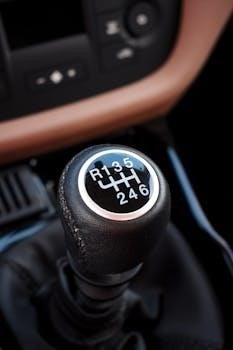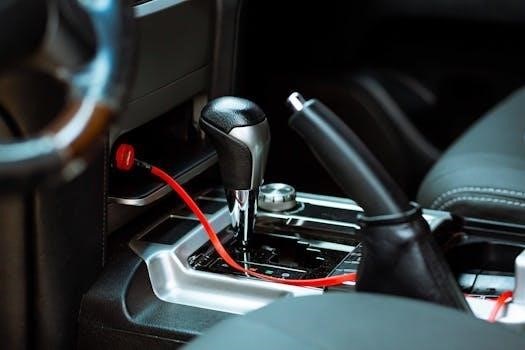The 4L60E transmission, a common automatic in GM vehicles, often requires rebuilding due to wear and tear. This process, while complex, can be managed using the right resources. This document will cover a detailed rebuild manual and related information for the 4L60E.
Overview of the 4L60E Transmission
The 4L60E is a four-speed automatic transmission widely used in General Motors vehicles, evolving from the Turbo-Hydramatic 700R4. It’s known for its electronic controls, making it a popular choice for various models. This transmission handles a range of power, but consistent use and high mileage often lead to wear on internal components. Common issues include problems with the 3-4 clutch pack, valve body issues, and pump malfunctions. Understanding its design and operation is crucial before undertaking a rebuild. The 4L60E’s design has seen some improvements over time, with the later 4L65E and 4L70E models sharing many parts. Rebuilding a 4L60E can be a rewarding project for DIY mechanics, provided they have the right tools, a clean workspace, and a comprehensive understanding of the process. The transmission requires precise measurements and attention to detail during disassembly and reassembly. The 4L60E is a popular choice for those wanting to work on their own transmissions.
Importance of a Rebuild Manual
A detailed rebuild manual is essential when tackling a 4L60E transmission rebuild. This manual serves as a roadmap, guiding you through the intricate process of disassembly, inspection, and reassembly. It provides specific torque specs, diagrams, and step-by-step instructions, ensuring accuracy and preventing mistakes. Without a manual, you risk damaging components or incorrectly assembling the transmission, leading to further issues and potential failure. The manual contains vital information about clutch clearances, valve body operation, and pump rebuilding, which are critical for optimal performance. It also helps with identifying worn or damaged parts, allowing you to replace them correctly. A rebuild manual is not just a guide; it’s a crucial tool that provides the necessary knowledge and procedures to successfully rebuild a 4L60E. Whether you are a seasoned mechanic or a DIY enthusiast, a quality manual is the key to a successful and long-lasting transmission repair.

Essential Resources for 4L60E Rebuild
Successfully rebuilding a 4L60E transmission requires access to reliable resources. These resources include comprehensive manuals, both printed and digital formats, which will assist with every step of the rebuild process.
Recommended ATSG Rebuild Manual
The Automatic Transmission Service Group (ATSG) manual stands out as a highly recommended resource for anyone undertaking a 4L60E transmission rebuild. This manual provides detailed, step-by-step instructions crucial for both seasoned technicians and newcomers to the process. The ATSG manual is known for its comprehensive coverage of the 4L60E transmission, offering clear diagrams, torque specifications, and specific procedures for disassembly, reassembly, and troubleshooting. It is often cited as the go-to guide because of its accuracy and the depth of information provided. Many professional mechanics and DIY enthusiasts alike depend on the ATSG manual for a successful rebuild. The manual covers all the intricacies of the 4L60E, including electronic controls, shift patterns, and specific component details. It also addresses common issues and offers guidance on how to avoid common pitfalls. The manual also details the proper procedures for inspection, diagnosis and troubleshooting, ensuring a thorough understanding of the process. Acquiring an ATSG manual is a worthwhile investment for a proper rebuild.
Free 4L60E Rebuild Manual PDF
Finding a free 4L60E rebuild manual in PDF format can be a great advantage for those looking to save on expenses. Many online sources offer downloadable PDF guides that cover the ins and outs of rebuilding this transmission. These free manuals often include detailed procedures, diagrams, and troubleshooting tips, making them a valuable resource for DIY mechanics. While these free PDF manuals may not be as comprehensive as the ATSG manual, they can provide a solid foundation for the rebuild process. Many of these guides feature step-by-step instructions and are designed to assist both beginners and experienced builders. A free PDF manual can also provide a good overview of the disassembly and reassembly process, along with helpful tips on identifying common issues. These resources sometimes include torque specifications, clutch clearance information, and details about specific components, giving you the knowledge needed for the job. While the information is helpful, remember to double check the instructions with other sources.

Preparing for the 4L60E Rebuild
Before beginning your 4L60E transmission rebuild, gathering the necessary tools and understanding available rebuild kits is essential. Proper planning will ensure a smoother and more successful rebuild process.
Essential Tools for the Rebuild
Rebuilding a 4L60E transmission requires a specific set of tools to ensure proper disassembly, repair, and reassembly. These tools are crucial for achieving a successful and reliable rebuild. You’ll need a comprehensive set of mechanic’s tools, including sockets, wrenches, and pliers. Specialized tools specific to transmission work are also necessary. A torque wrench is essential for tightening bolts to the correct specifications, preventing damage to components. A snap ring pliers is needed for removing and installing retaining rings. A dial indicator and calipers will be necessary for measuring clearances accurately. Teflon sealing ring installers and resizing tools are often required to handle seals properly. A transmission jack is also needed for safely moving and positioning the transmission. A shop press is helpful for removing and installing gears and bearings. Having a clean workbench and proper lighting is also important. This will ensure a successful and smooth rebuild process.
Understanding 4L60E Rebuild Kits
4L60E rebuild kits are essential for overhauling your transmission, containing all the necessary parts for a successful rebuild. These kits come in different levels, each designed to address specific needs and budgets. An overhaul kit typically includes basic seals, gaskets, and o-rings to replace worn soft parts. A banner kit adds friction clutches, which are important for smooth gear changes. The master kit is the most comprehensive, providing everything in the banner kit plus steels, bands, a filter, and bushings. Some kits even offer upgraded components for improved performance and durability. When selecting a kit, consider the transmission’s condition, your driving style, and if you need any upgrades. Research the different options available and choose the kit that best suits your needs and budget. Always ensure the kit you purchase is compatible with your specific 4L60E model and year. High quality components in your rebuild kit will ensure a long and reliable service life.

4L60E Rebuild Procedures
Rebuilding a 4L60E involves a meticulous process, starting with careful disassembly. Key steps include inspecting components, cleaning thoroughly, and reassembling with precision. Following a detailed manual is essential for success;
Step-by-Step Disassembly Guidance
Disassembling a 4L60E transmission requires a systematic approach, ensuring each component is carefully removed and organized. Begin by draining the transmission fluid and cleaning the exterior. Next, remove the pan and filter, followed by the valve body and related components. Pay close attention to the locations of check balls and springs, as these are critical for proper reassembly. The pump assembly should be removed next, noting the position of the pump rotor and veins. Disconnect the manual valve link and remove the manual shaft. Proceed to dismantle the input and output shafts, carefully separating the clutch packs and other internal parts. It is crucial to document each step and keep all parts labeled to prevent confusion during reassembly. Remember that cleanliness is paramount during this process to avoid contamination. The use of a detailed 4L60E rebuild manual will be invaluable, providing specific instructions and diagrams. This meticulous disassembly sets the stage for a successful rebuild.
Key Areas⁚ Pump, Valve Body, Clutches
When rebuilding a 4L60E transmission, certain areas require particular attention due to their complexity and impact on performance. The pump, responsible for generating hydraulic pressure, must be thoroughly inspected for wear, especially the pump rotor, veins, and springs. The valve body, which controls fluid flow, needs to be meticulously cleaned and inspected for worn valves or check balls, as these can cause shift problems. The clutches, including the forward, direct, and 3-4 clutches, must be carefully examined for wear and damage. Replacing worn clutch friction plates and steel plates is essential for proper engagement and performance. Pay attention to the clutch pack clearances, ensuring they meet the manufacturer’s specifications for smooth shifts. Proper reassembly of these key areas is vital for the overall functionality of the rebuilt transmission. These areas are often the root cause of many common 4L60E issues, making their thorough inspection and correct rebuild critical.
Reassembly Process and Clutch Clearance
The reassembly of a 4L60E transmission requires a systematic approach, ensuring all components are correctly installed and torqued to specification. Following the detailed steps in a 4L60E rebuild manual is crucial to avoid errors that may lead to future problems. Pay close attention to the installation of sealing rings, gaskets, and O-rings, ensuring they are properly positioned to prevent leaks. During the reassembly, special attention must be given to the clutch packs. This involves ensuring that the correct number of friction plates and steel plates are installed in the proper order and that the clutch clearances are within the specified limits. Clutch clearance is critical for proper clutch engagement and shift timing. Using a feeler gauge, measure each clutch pack’s clearance, adjusting with selective plates as necessary, according to the manufacturer’s recommended values. Incorrect clutch clearance can cause slipping, delayed shifts, or premature failure. Proper reassembly and clutch clearance are paramount for a successfully rebuilt transmission.

Common Issues and Upgrades
The 4L60E transmission is known for specific failure points. Understanding these issues and considering potential upgrades during a rebuild can enhance its reliability. This section will discuss those areas and improvements.
Addressing Known 4L60E Problems
The 4L60E transmission, while widely used, has several common issues that often surface with age and mileage; A frequent problem is the failure of the 3-4 clutch pack, leading to slipping or complete loss of 3rd and 4th gears. This can be attributed to design limitations and high stress on these components. Another significant concern is valve body wear, which can cause erratic shifting, delayed engagements, and overall poor transmission performance. The pump assembly is also prone to wear, resulting in reduced line pressure and inadequate lubrication, which can lead to further component damage. The sun gear shell is also a known weak point. Additionally, the transmission’s electronics, including solenoids and sensors, can fail, causing shifting issues and error codes. Identifying and addressing these known issues is crucial during a rebuild to ensure the transmission’s longevity and optimal performance. Proper diagnosis and replacement of worn or damaged parts are essential steps in the rebuilding process. Furthermore, using high-quality components and following the correct procedures detailed in a rebuild manual can significantly mitigate the risk of recurring problems.
Potential Upgrades and Improvements
When rebuilding a 4L60E transmission, several upgrades and improvements can be implemented to enhance its performance and durability. One common upgrade is the installation of a heavy-duty 3-4 clutch pack, which can withstand higher stress and prevent premature failure. Upgrading the sun gear shell to a stronger, hardened version is also crucial for increased reliability. Another worthwhile improvement is to install a shift kit, which modifies the valve body to provide firmer and quicker shifts. This can enhance the transmission’s overall performance and responsiveness. Furthermore, replacing the stock pump with a high-volume pump can ensure adequate fluid flow and lubrication, especially under demanding conditions. Using performance frictions and steels can also provide better holding power and heat resistance. For improved cooling, an upgraded transmission cooler can help maintain optimal operating temperatures. Some builders also modify the valve body to allow manual shifting. Addressing these weak points and incorporating these upgrades during a rebuild can significantly extend the life of the transmission and enhance its performance.

